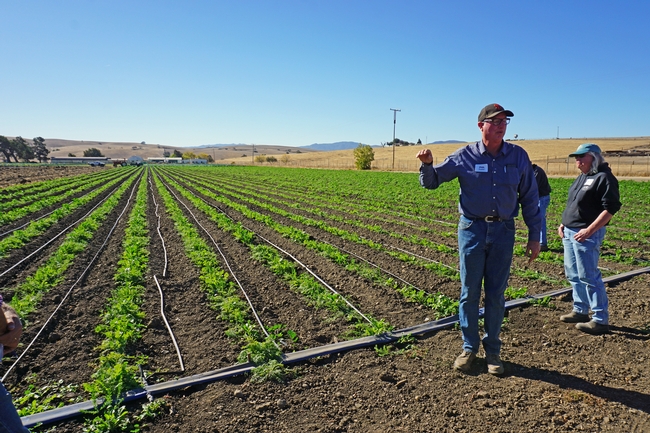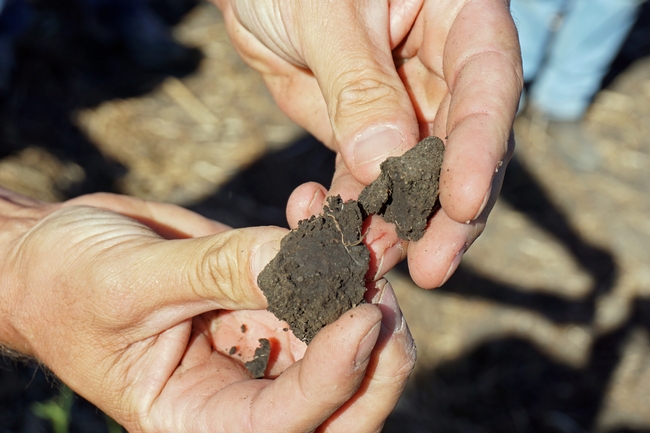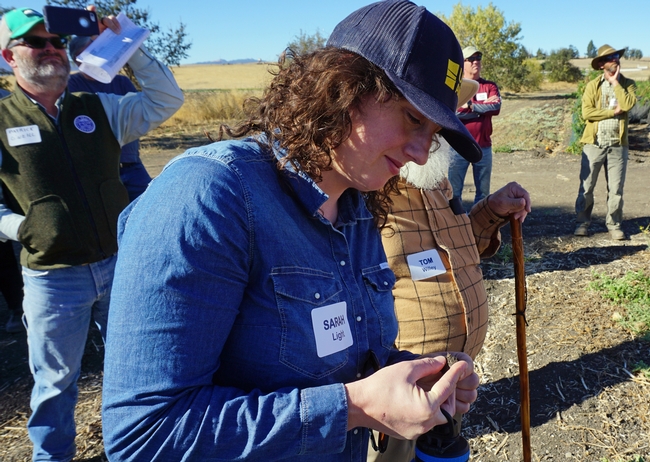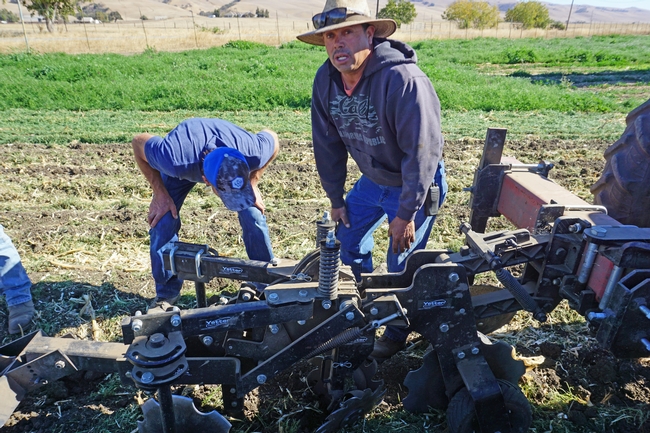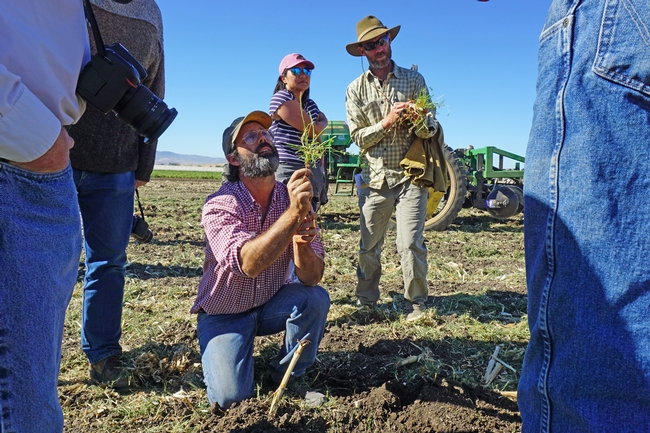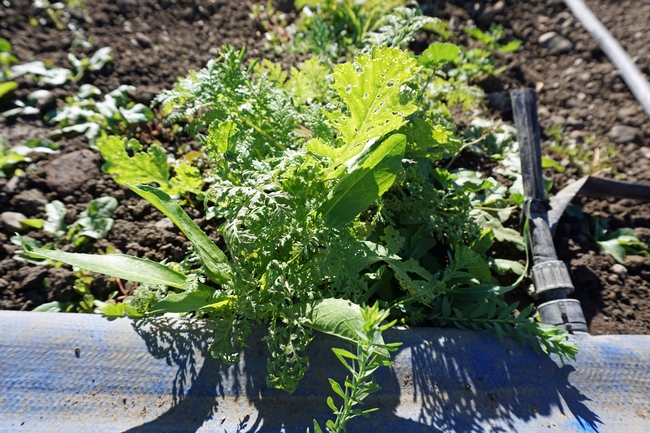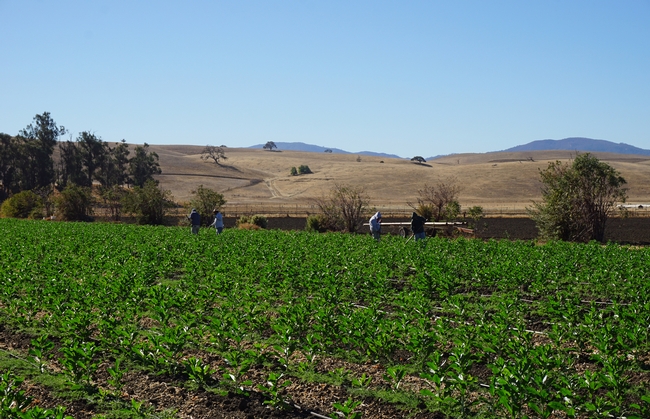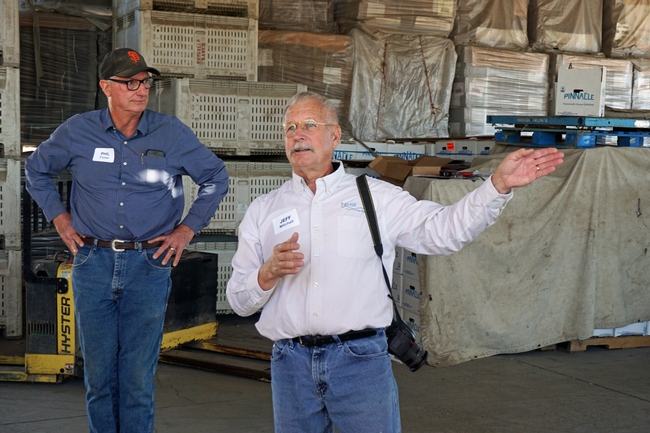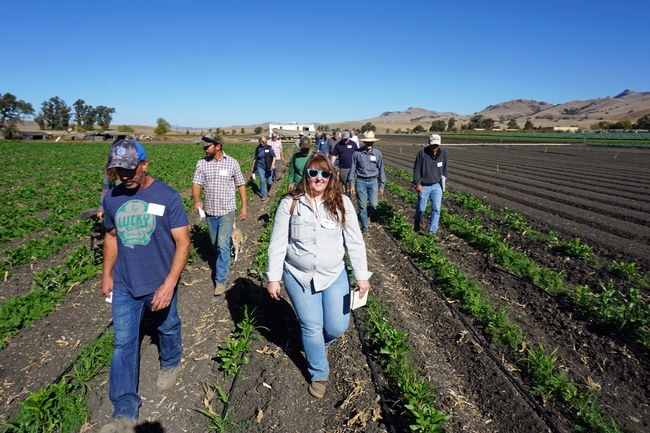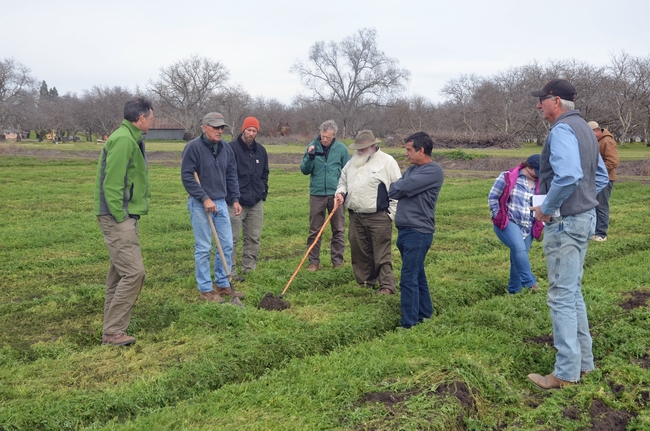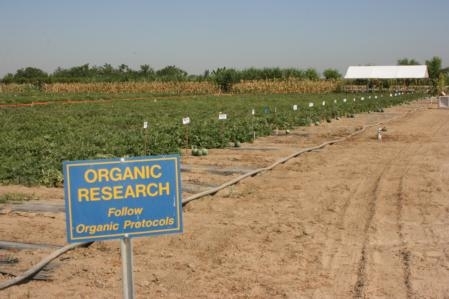Posts Tagged: organic
Laura Burkle Seminar: Plant-Pollinator Interactions
One reason to research plants is that “they stay put.” But more about that later. Community ecologist Laura Burkle, associate professor...
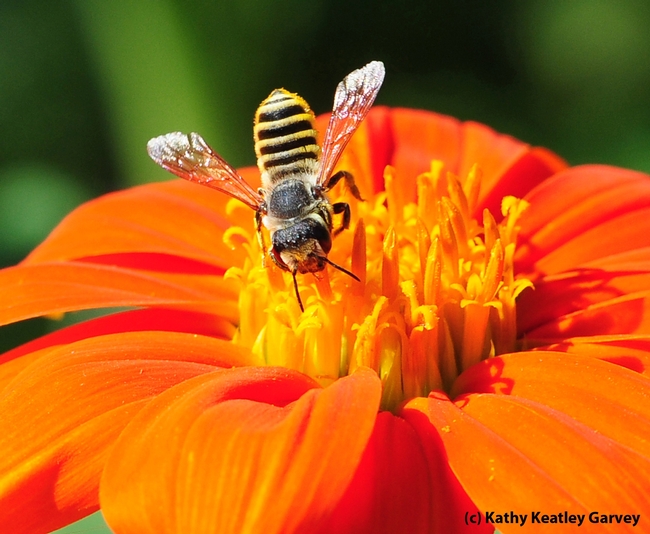
Female leafcutting bee, Megachile fidelis, foraging on a Mexican sunflower. (Photo by Kathy Keatley Garvey)
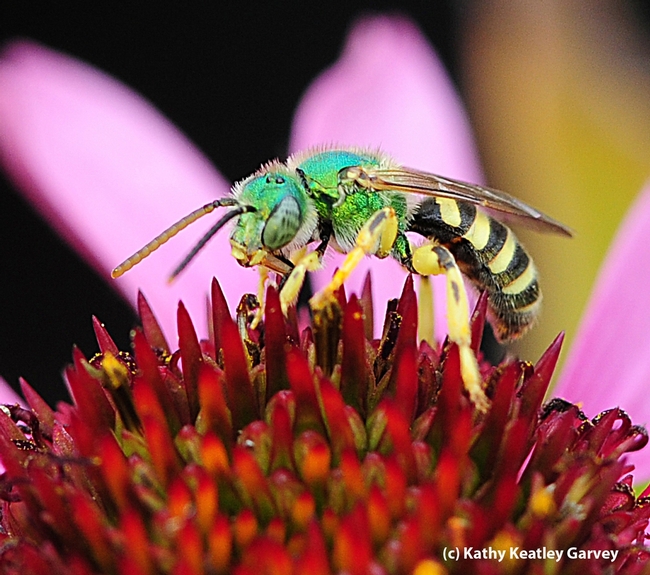
Female sweat bee, Agapostemon texanus, on purple coneflower. (Photo by Kathy Keatley Garvey)
Organic farmers and researchers strive to advance soil care
Organic farmer Phil Foster has developed a creative way to nurture the soil on his 200-acre farm near Hollister. He plants cover crops in a single line at the top of the planting bed, saving water and seed while keeping the furrows clear for irrigation.
"We were finding we couldn't use cover crops because of water," Foster said. The narrow strip makes the best use of the limited water supply, while garnering the benefits of cover crops - which buffer soil temperatures, inhibit weeds, increase soil microbial activity, improve water infiltration and add nutrients. Growing cover crops prepares the soil for the production of high-quality vegetables.
Foster is one of eight organic vegetable growers who are working with researchers at Chico State, Fresno State and UC Agriculture and Natural Resources on a project funded with a USDA grant designed to make significant improvements in soil care in organic production systems. He guided project participants around his farm, equipment yard and compost operation in early November to share the techniques he and his staff have developed over three decades to promote soil health.
Tour participants marveled at the soil characteristics, admiring tiny pores and roots in clods of dirt, evidence of the soil's capacity to move water and nutrients. They studied the plant and soil conditions after farm manager Efrain Contreras pulled a carefully crafted implement for rolling down the cover crop across the field with a tractor.
Foster credited Contreras, a 30-year employee, for his role in building the soil on the farm. Labor, Foster said, is his biggest cost. He has 50 full time staff, many with 5 to 20 years of experience.
"They are the key to to the success of the ranch," Foster said.
Minimizing and, eventually eliminating, soil disturbance can be combined with organic groundcover, year-round root growth and robust biological activity in the soil to further promote soil health. Following the tour, the farmers talked about ways to attain the goal on their farms of no-till organic vegetable production.
Foster said he will experiment with reducing soil disturbance to determine whether doing so will maintain or increase yields. Another farmer in the project, Scott Park of Meridian, Calif., 50 miles north of Sacramento, said he will dedicate eight acres of his organic farm to comparing the results when the cover crop is chopped and left on the soil surface to chopped and incorporated with tillage.
Paul Muller and Andrew Braitt of Fully Belly Farm in the Capay Valley suggested the researchers could help the farmers by identifying optimal, effective cover crop rolling techniques. Retired organic farmer Tom Willey of Madera suggested grant funds be used to purchase appropriate scale cover crop seeders for on-farm experimentation.
"We're making great progress," said project coordinator Jeff Mitchell, UC Cooperative Extension vegetable crops specialist. "By getting together regularly, we're seeing opportunities for moving further toward reduced-disturbance on the farms, identifying the equipment needs and establishing effective channels of communication."
Over the project's three-year term, the farmers and researchers will continue to experiment with soil-building techniques and share results.
University researchers and organic farmers to build soil as nature intended
A USDA grant will allow a group of California organic farmers to team up with researchers from the University of California, Chico State and Fresno State to determine whether tilling less soil on the farm will improve production of vegetable crops.
The aim is to duplicate the soil environment found in natural areas – typically concealed by plants, leaves and other organic debris – to improve agricultural soil health, increase production, reduce water use and avoid leaching nutrients out of the root zone.
“Tilling the soil is common on farms, but our research shows that it often isn't necessary, and can even be detrimental,” said Jeff Mitchell, UC Cooperative Extension agronomy specialist. “In nature, organic matter on the soil surface creates a protective layer and promotes biological activity that is beneficial to plants and the environment.”
The three-year project, funded with $380,000 from the USDA Natural Resources Conservation Service's Conservation Innovation Grant program, involves six organic farmers who are already experimenting on their own with cover crops, compost and minimum tillage to grow high-quality organic produce.
“This is a group of outstanding farmers,” Mitchell said. “It's very encouraging to see this sort of care for the soil. They recognize that taking care of the soil biology is useful to produce crops.”
One of the participants, Scott Park of Meridian, Calif., 50 miles north of Sacramento, has been building the soil on his farm for 38 years.
“We put 10 to 15 tons of biomass on every acre every year,” Park said. “This has given me good soil structure, water percolation and water retention, and we're having some really good results.”
Park said he tweaks his farming practices each year. To date, he has tinkered with reduced tillage, but isn't sold on a no-till system.
“I'm doing minimum till now, but it can be better,” Park said.
Teasing out those improvements is a goal of the project, which includes trials on four farms and two 12-acre demonstration plots, one at the UC West Side Research and Extension Center in Five Points and the other on the Chico State campus.
“Each of us will be trying to get closer to the goal of reducing tillage to promote soil health. We all want to develop strategies that might work, and not repeat mistakes,” Mitchell said.
The USDA grant funds will enable the farmers and researchers to gather accurate data about the agronomic and economic impacts of the new farming systems and use state-of-the-art equipment and technologies as they experiment with new techniques.
For example, the team is working with a Salinas company that is bringing a Spanish transplanting technology to California. The company, Tanimura & Antle Produce, will allow a demonstration of a plant tape that holds sprouts spaced ideally for a broccoli field planting in the West Side REC plot. (See video below or on YouTube at https://youtu.be/6pkmQVNjH1I .) The technology holds promise for reducing tillage, cutting back on labor, using less seed, and bringing the crop into production earlier in the season.
Planting cover crops is another way farmers and researchers will seek to improve soil health, though this process is a challenge in organic farming systems. On conventional no-till and minimum-till farms, the cover crop may be sprayed with an herbicide before planting seedlings in the cover crop residue. Possible solutions are chopping up the cover crop or using a roller-crimper machine.
“These technologies would provide considerable advantages in organic systems, but very little research has been done to quantify how these practices might influence soil function and cropping system resilience in California,” Mitchell said.
As part of the project, a farmer network will be developed for information sharing, 18 public extension events will be held, six videos will be created and curriculum will be developed to extend the research outcomes.
For more information, contact Jeff Mitchell at jpmitchell@ucanr.edu, or (559) 303-9689.
In the video below, see an overview of transplanting technology developed in Spain that will be part of the soil building research.
Organic symposium proceedings now available
Summaries of presentations from the 2016 Organic Agriculture Research Symposium (OARS) held in Pacific Grove are now available online at http://eorganic.info/node/16778. Many of the workshops and keynote presentations were recorded live and may be viewed via the eOrganic YouTube channel.
The event, which was co-sponsored by the Organic Farming Research Foundation and UC Kearney Agricultural Research and Extension Center, covered topics ranging from soil health, seeds, plant breeding, and biological control, to biodiversity, economics, and livestock — all with a focus on organic production.
“We are making these presentations available free online to extend the reach of all the valuable information shared at the symposium,” said Jeff Dahlberg, director of the UC Kearney Agricultural Research and Extension Center. “We're now planning the 2017 symposium and it will build on the cutting edge research shared by scientists this year.”
In the opening address, president of Organics International, André Leu, said organic agriculture offers the promise of a future to produce and distribute food and other farm products in a healthy, economically sound, truly sustainable and fair way. He called the current state of organic agriculture “Organic 3.0.”
“This is a concept we put out a year ago and it is resonating around the world,” Leu said. Organic 1.0 dates back to the 1920s and represents organic farming founders and visionaries, he said. Organic 2.0, beginning in the 1970s, represents the establishment of private standards, public regulations and global recognition. The current stage of organic farming is a time for market reinvention, widespread conversion and performance improvement.
Financial support for the 2016 OARS was provided by the USDA National Institute for Food and Agriculture Organic Research and Extension Initiative and the Gaia Fund.
"The OARS conference was very successful in bringing national and international scholars and farmers together to present findings about the latest research and how it is advancing organic farming and ranching," said Diana Jerkins, OARF research director. "OFRF will continue to encourage and participate in events such as these to ensure current research, education, and extension efforts are widely disseminated."
Organic Farming Research Foundation is a non-profit foundation that works to foster the improvement and widespread adoption of organic farming systems. OFRF cultivates organic research, education, and federal policies that bring more farmers and acreage into organic production.
The UC Kearney Agricultural REC is one of nine UC Agriculture and Natural Resources research and extension centers across the state of California. Ten acres at the 330-acre center are certified organic and available for organic research.
Honey, I Hardly Know Ya
Ever been to a Farmer's Market and picked up a jar of honey advertised as "organic?" Is it organic? And if you're a beekeeper, has a consumer ever...
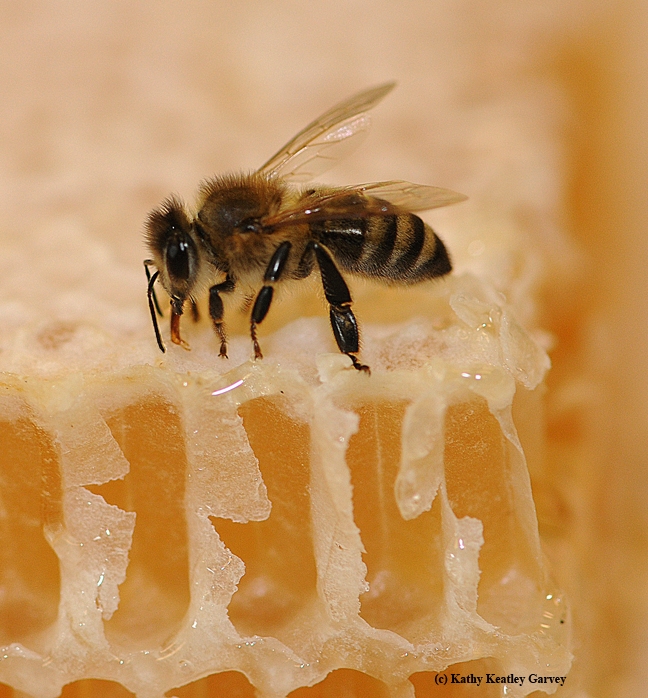
Honey bee sipping honey. (Photo by Kathy Keatley Garvey)


